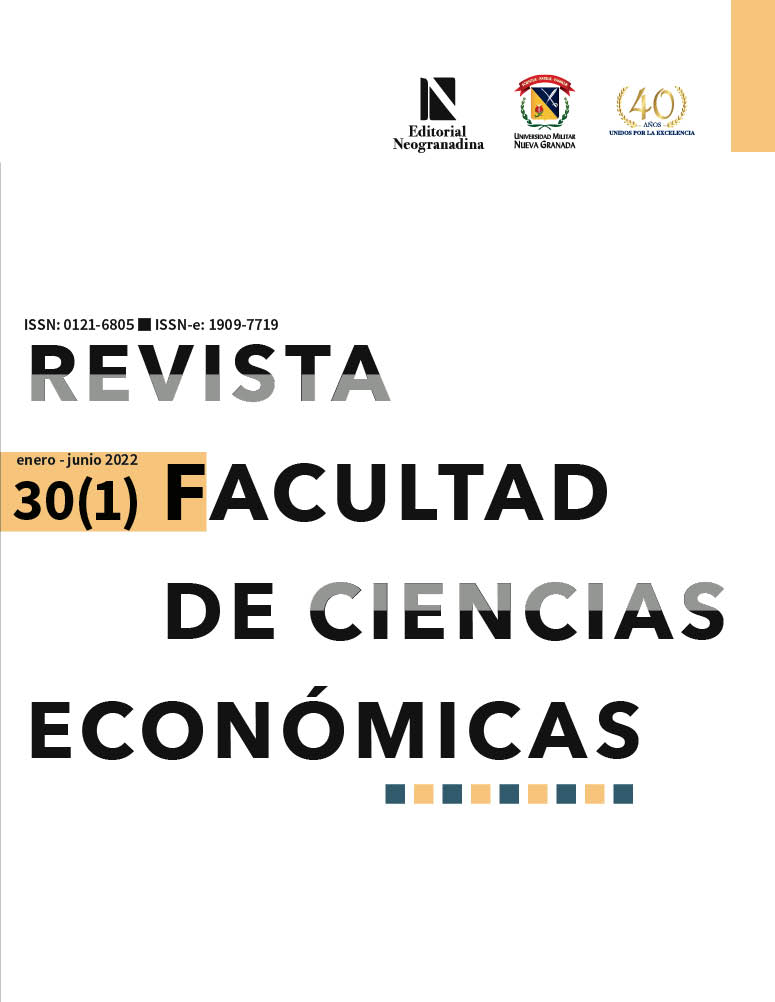Effects of trade agreements and road connectivity on manufactured exports from Argentina, Chile, Paraguay and Uruguay
Abstract
This study aims to determine the effect of Mercosur, Chile's bilateral agreements and road connectivity on exports of manufactured goods from Argentina, Chile, Paraguay and Uruguay, during the period 2002-2016. In order to carry this out, a gravitational model is specified. The main results indicate that there is no significant effect of Mercosur on the manufacturing exports of Argentina, Paraguay and Uruguay, nor of any bilateral agreement signed by Chile. In addition, the manufacturing exports of the countries under study have a dynamic behavior, positively conditioned by the amount of goods exported during the previous year. The greater the gross domestic product per capita of the exporter and importer and the kilometers of paved highways and railway lines of the exporting country, the greater the exportable amount in manufactured goods. Lastly, it confirms that international transport costs prevent an increase in manufacturing exports.
Downloads
References
Asociación Latinoamericana de Integración (ALADI). (2003). Estructura y evolución de la pauta exportadora de cada país miembro de la ALADI y el papel del comercio negociado. aladi/sec/Estudio 164. http://www2.aladi.org/nsfaladi/estudios.nsf/438f22281c05235303256848005ea465/41770927fb1d55dd03256e300059e688/$FILE/164.pdf
Asociación Latinoamericana de Integración (ALADI). (2015). Sistema de información de comercio exterior. Estadísticas de comercio exterior por grupo de ítems. https://www.aladi.org/accesoamercados/
Asociación Latinoamericana de Integración (ALADI). (2020). Sistema de información de comercio exterior. Estadísticas de comercio exterior por grupo de ítems. https://www.aladi.org/accesoamercados/
Anderson, J. (1979). A Theoretical Foundation for the Gravity Equation. American Economic Review, 69(1), 106-116.
Aquevedo, E. (2020). América Latina: de la substitución de importaciones al auge neoliberal. Última Década, 5(7), 129-137. https://revistas.uchile.cl/index.php/UD/article/view/56232/59477
Arellano, M. y Bond, S. (1991). Algunas pruebas de especificación para datos de panel: evidencia de Monte Carlo y una aplicación a las ecuaciones de empleo. La revisión de estudios económicos, 58 (2), 277-297.
Arellano, M. y Bover, O. (1995). Another Look at the Instrumental Variables Estimation of Error Component Models. Journal of Econometrics, 68, 29-51. DOI: https://doi.org/10.1016/0304-4076(94)01642-D
Bekerman, M., Dulcich, F. y Moncaut, N. (2014). La emergencia de China y su impacto en las relaciones comerciales entre Argentina y Brasil. Problemas del Desarrollo, 45(176), 55-82. DOI: https://doi.org/10.1016/S0301-7036(14)70850-8
Benavente, J. M. (2001). Exportaciones de manufacturas de América Latina: ¿Desarme unilateral o integración regional? CEPAL: Serie Macroeconomía del Desarrollo No. 3. http://hdl.handle.net/11362/5394
Bergstrand, J. (1985). The Gravity Equation in International Trade: Some Microeconomic Foundations and Empirical Evidence. The Review of Economics and Statistics, (71), 143-153. DOI: https://doi.org/10.2307/1925976
Bernal-Meza, R. (2013). Modelos o esquemas de integración y cooperación en curso en América Latina (UNASUR, Alianza del Pacífico, ALBA, CELAC): una mirada panorámica. Ibero-Amerikanisches Institut, Stiftung Preußischer Kulturbesitz. http://biblioteca.clacso.edu.ar/Alemania/iai/20161117032353/pdf_1393.pdf
CEPAL. (1973). El desarrollo de las exportaciones no tradicionales de América Latina: contribución a la evaluación de la estrategia internacional del desarrollo. CEPAL.
CEPAL. (2002) Panorama de la inserción internacional de América Latina y el Caribe, 2000-2001. CEPAL. https://www.cepal.org/es/publicaciones/1194-panorama-la-insercion-internacional-america-latina-caribe-2000-2001
CEPAL. (2003) Panorama de la inserción internacional de América Latina y el Caribe, 2001-2002. CEPAL. https://www.cepal.org/es/publicaciones/1196-panorama-la-insercion-internacional-america-latina-caribe-2001-2002
Dantas, A. T. (2006). El fracaso del ALCA y el MERCOSUR. Estudios: Centro de Estudios Avanzados, (18), 73-81.
Edwards, S. (1988). Terms of Trade, Tariffs, and Labor Market Adjustment in Developing Countries. The World Bank Economic Review, 2(2), 165-185. DOI: https://doi.org/10.1093/wber/2.2.165
Eichengreen, B. e Irwin, D. (1997). The Role of History in Bilateral Trade Flows. J. Frankel. (Ed.), Regionalization of the World Economy, (pp. 33-57). University of Chicago Press. DOI: https://doi.org/10.7208/chicago/9780226260228.003.0003
Fuenzalida-O'Shee, D., Valenzuela-Klagges, B. y Corvalán-Quiroz, A. (2018). Trade facilitation and its effects on Chile's bilateral trade between 2006 and 2014. CEPAL Review, (124). DOI: https://doi.org/10.18356/4b373fd6-en
Fung, K. C., Hwang, H.-C., Ng, F. y Seade, J. (2015). Production networks and international trade: China, Brazil and Mexico. The North American Journal of Economics and Finance, 34, 421-429. DOI: https://doi.org/10.1016/j.najef.2015.09.002
Jucá, M., Cardozo, M. y Arteaga, J. (2021) Comercio con China: composición de la cesta comercial y crecimiento económico en Latinoamérica. Encuentro Nacional de Economía Industrial e Innovación. V ENEI. Innovación, Sustentabilidad y Pandemia. Mayo, Brasil. http://pdf.blucher.com.br.s3-sa-east-1.amazonaws.com/engineeringproceedings/v-enei/754.pdf
Helpman, E. y Krugman, P. (1985). Market Structure and Foreign Trade. Increasing Returns, Imperfect Competition, and the International Economy. The MIT Press.
Hoffmann, J. (2000). El potencial de puertos pivotes en la costa del Pacífico sudamericano. Revista de la CEPAL, (71), 121-143. DOI: https://doi.org/10.18356/97c9ce42-es
Kyvik, H. y Piermartini, R. (2004). Infrastructure and Trade. WTO Staff Working Paper, (ERSD-2004-04). DOI: https://doi.org/10.2139/ssrn.923507
Kouzmine, V. (2001). El comercio entre América Latina y los países de Europa Central y Oriental en los años noventa. CEPAL, Serie Comercio Internacional, (15). http://hdl.handle.net/11362/4354
Limao, N. y Venables, A. (2001). Infraestructure, Geographical Disadvantage, Transport Costs and Trade. World Bank Economic Review, 15(3), 451-479. DOI: https://doi.org/10.1093/wber/15.3.451
Linnemann, H. (1966). An Econometric Study of International Trade Flows. Holland Publishing.
Messner, D. (1996). Latinoamérica hacia la economía mundial: condiciones para el desarrollo de la "competitividad sistémica". Aportes Prosur.
Ocampo, J. A. (2009). Impactos de la crisis financiera mundial sobre América Latina. Revista CEPAL, (97). DOI: https://doi.org/10.18356/341cc175-es
Paes, R. y Corseuil, C. (2001). Apertura Económica y Distribución del Ingreso en Brasil. En E. Ganuza, R. Paes de Barros, L. Taylor y R. Vos. (Eds.). Liberalización, desigualdad y riqueza: América Latina y el Caribe en los 90. Editorial Universitaria de Buenos Aires.
Perrotti, D. (2015). La República Popular de China y América Latina: impacto del crecimiento económico chino en las exportaciones latinoamericanas. Revista CEPAL, (116), 48-60. DOI: https://doi.org/10.18356/28c65188-es
Pöyhönen, P. (1963). A Tentative Model for the Volume of Trade between Countries. Weltwirtschaftliches Archiv, (90), 93-99. http://www.jstor.org/stable/40436776
Quiroz, E. (2009). Crisis económica mundial 2008-2009, bumerán de la globalización. Justicia, 14(15). http://revistas.unisimon.edu.co/index.php/justicia/article/view/964
Santos, E. (2015). El Mercosur y su papel para la "nueva" inserción brasileña en el proceso de acumulación global [Tesis doctoral, Universidad Complutense de Madrid]. Archivo digital. https://eprints.ucm.es/id/eprint/29633/
Silva, J. M. C. y Tenreyro, S. (2006). The Log of Gravity. The Review of Economics and statistics, 88(4), 641-658. DOI: https://doi.org/10.1162/rest.88.4.641
Tinbergen, J. (1962). Shaping the World Economy. Suggestions for an International Economic Policy. Twentieth Century Fund.
Torres, D. y Gilles, E. (2012). Exportaciones industriales de Colombia: estructura tecnológica, sofisticación y diversificación (1990-2010). Cuadernos de Economía, 31(SPE57), 201-220.
Torres, D. y Gilles, E. (2013). Estructura tecnológica de las exportaciones industriales en América Latina (1990-2010). AD-minister (22), 96-111. http://publicaciones.eafit.edu.co/index.php/administer/article/view/2028
Valenzuela-Klagges, B. y Fuenzalida, D. (2020). Efectos de la inversión extranjera y competitividad en el comercio y productividad de países latinoamericanos. Economía y Sociedad, 25(57), 110-125. DOI: https://doi.org/10.15359/eys.25-57.6
Wall, H. (2003). NAFTA and the Geography of North American Trade. Federal Reserve Bank of St. Louis, 85, 13-26. DOI: https://doi.org/10.20955/r.85.13-26
Yeaple, S. y Golub, S. (2007). International Productivity Differences, Infraestructure and Comparative Advantage. Review of International Economics, 15(2), 223-242. DOI: https://doi.org/10.1111/j.1467-9396.2007.00667.x
Copyright (c) 2022 Revista Facultad de Ciencias Económicas

This work is licensed under a Creative Commons Attribution-NonCommercial-NoDerivatives 4.0 International License.











